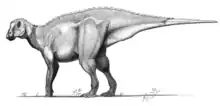Hypselospinus
Hypselospinus is a genus of iguanodontian dinosaur which was first described as a species of Iguanodon (I. fittoni) by Richard Lydekker in 1889, the specific name honouring William Henry Fitton.[1]
| Hypselospinus | |
|---|---|
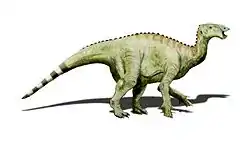 | |
| Restoration | |
| Scientific classification | |
| Kingdom: | Animalia |
| Phylum: | Chordata |
| Clade: | Dinosauria |
| Order: | †Ornithischia |
| Suborder: | †Ornithopoda |
| Clade: | †Ankylopollexia |
| Clade: | †Styracosterna |
| Genus: | †Hypselospinus Norman, 2010 |
| Species: | †H. fittoni |
| Binomial name | |
| †Hypselospinus fittoni | |
| Synonyms | |
In May 2010 the fossils comprising Hypselospinus were by David Norman reclassified as a separate genus, among them the holotype BMNH R1635, consisting of a left ilium, a sacrum, tail vertebrae and teeth. The generic name is derived from Greek hypselos, "high" and Latin spina, "thorn", in reference to the high vertebral spines. Later that same year, a second group of scientists independently re-classified I. fittoni into a new genus they named Wadhurstia,[2] which thus is a junior objective synonym of Hypselospinus. Hypselospinus lived during the lower Valanginian stage, around 140 million years ago.[2][3] A contemporary of Barilium (also once thought to be a species of Iguanodon), Hypselospinus was a lightly built iguanodontian estimated at 6 metres (19.7 ft) long.[4] The species Iguanodon fittoni was described from the lower Valanginian-age Lower Cretaceous Wadhurst Clay[2] of East Sussex, England.[5] Remains from Spain may also pertain to it. Norman (2004) wrote that three partial skeletons are known for it,[5] but this is an error.[6]
Hypselospinus is separated from Barilium on the basis of vertebral and pelvic characters, size, and build.[4] For example, Barilium was more robust than Hypselospinus, with large Camptosaurus-like vertebrae featuring short neural spines, whereas Hypselospinus is known for its "long, narrow, and steeply inclined neural spines".[5]
References
- Lydekker, Richard (1889). "Notes on New and other dinosaurian remains". Geological Magazine. 6 (8): 352–356. doi:10.1017/S0016756800176587.
- Carpenter, K. and Ishida, Y. (2010). "Early and “Middle” Cretaceous Iguanodonts in Time and Space." Journal of Iberian Geology, 36 (2): 145-164.
- Norman, David B. (2010). "A taxonomy of iguanodontians (Dinosauria: Ornithopoda) from the lower Wealden Group (Cretaceous: Valanginian) of southern England" (PDF). Zootaxa. 2489: 47–66. doi:10.11646/zootaxa.2489.1.3.
- Blows, W. T. (1997). "A review of Lower and middle Cretaceous dinosaurs from England". In Lucas, S.G.; Kirkland, J.I.; Estep J.W. (eds.). Lower and Middle Cretaceous Terrestrial Ecosystems. New Mexico Museum of Natural History and Science Bulletin, 14. New Mexico Museum of Natural History and Science. pp. 29–38.
- Norman, David B. (2004). "Basal Iguanodontia". In Weishampel, D.B.; Dodson, P.; Osmólska H. (eds.). The Dinosauria (2nd ed.). Berkeley: University of California Press. pp. 413–437. ISBN 0-520-24209-2.
- Naish, Darren; Martill, David M. (2008). "Dinosaurs of Great Britain and the role of the Geological Society of London in their discovery: Ornithischia". Journal of the Geological Society, London. 165 (3): 613–623. doi:10.1144/0016-76492007-154. S2CID 129624992.

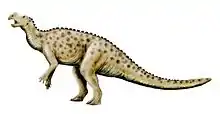

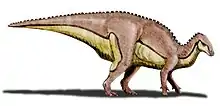
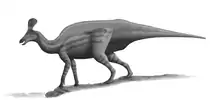
.jpg.webp)
